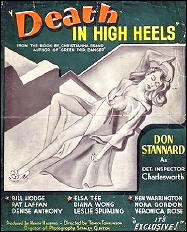Fri 23 Jul 2010
A Review by Curt Evans: CHRISTIANNA BRAND – Death in High Heels.
Posted by Steve under Reviews[4] Comments
CHRISTIANNA BRAND – Death in High Heels. John Lane/Bodley Head, UK, hardcover, 1941. Charles Scribner’s Sons, US, hc, 1942. Paperback reprints: Pan, UK, 1948; Carroll & Graf, US, 1989 (shown). Series character: Inspector Charlesworth. Film: Marylebone, 1947; with Don Stannard as Det. Charlesworth. Director: Don Stannard.

I found Christianna Brand’s ’prentice novel still quite enjoyable on my second reading. While the mystery plot is only mildly interesting, being not tremendously complex and but lightly clued, Brand does a fine job of keeping the reader hanging on to rapidly shifting suspicions and turns of events — a technique she beautifully perfected a few years later in her widely acknowledged masterpiece, Green for Danger. (One event here, though, rather melodramatically absurd, is hard to swallow.)
What I enjoy most about Death in High Heels is the setting, which is one of the best realized of the Golden Age period (if we stretch the usually accepted years of the Golden Age just slightly). The dress shop atmosphere, with its colorful coterie of ladies and men (along with designer Mr. Cecil, who is somewhere in between the two previously mentioned sexes), is strongly and amusingly conveyed.
The dumb stereotype of British Golden Age mystery — that all these books take place in upper-class country houses, posh London flats or highly stratified Cranford-style villages — certainly is belied by Brand’s first novel, which takes place in a hard-nosed London business establishment where most of the characters are working girls who by no means are economically well-settled.

Brand was such a “girl” and worked in such an establishment herself, I believe, which certainly lends authenticity to her setting in Death in High Heels.
Especially refreshing in Death in High Heels is the light badinage about sex. The ladies are breezily and pleasantly irreverent on this subject, while the presentation of Mr. Cecil and “the boyfriend” seems quite explicit for the time (even the most obtuse reader of the day must have recognized s/he was reading about a “gay” couple).
Unlike some of Ngaio Marsh’s portrayals of gay men from the same period, Brand’s presentation of the colorful Mr. Cecil, while admittedly comically broad, comes off, in my view, as genuinely amusing rather than merely demeaning. And each of the numerous dress shop ladies comes across as a distinct individual, a distinct achievement on the part of the author.
Though nearly seventy years old, Death in High Heels has dated not much at all. It’s one of the best “workplace atmosphere” mysteries of the period, I believe.
Editorial Comment: The crime fiction of Christianna Brand has been reviewed several times on this blog. Most recently was Marcia Muller’s review of Green for Danger, from 1001 Midnights. Following this link will lead you to that review, which in turn contains links to four earlier reviews.
July 23rd, 2010 at 11:02 pm
Don Stannard only made 11 films before his tragic early death. After this he made only four more films including the three DICK BARTON films for Hammer.
Incidentally a sequel to Brand’s NANNY MCPHEE character played by Emma Thompson is planned.
July 23rd, 2010 at 11:44 pm
Hoping not to go off in another direction altogether — but who can predict what paths these comments take? — NANNY McPHEE RETURNS has already played in England and is scheduled to begin here in the US in mid-August:
http://www.nannymcphee.com/
I have to confess that I never realized that Christianna Brand had anything to do with the first film, NANNY McPHEE. I quickly got the idea it was pretty much a retread of MARY POPPINS, and as soon as that happened, I’m afraid I ignored it from that point on.
— Steve
July 24th, 2010 at 12:47 am
I have to admit I was shocked to find Brand was as well — or better — known for NANNY MCPHEE as she was for her mystery fiction.
This is one I haven’t read, but sounds like I would like to. As Curt says the setting isn’t all that remote from the Golden Age, which didn’t all take place in small villages and great houses. Sayer’s MURDER MUST ADVERTISE called on her own career in advertising and Marsh frequently used a theatrical background and in at least one a sheep station. At least one Innes novel finds Appleby shipwrecked with a murderer among his fellow survivors.
The Golden Age wasn’t all murder among the wealthy anymore than the hard boiled novel was always urban.
July 24th, 2010 at 6:33 am
Brand said she wrote this book in part as a way of killing off an awful co-worker (or boss, can’t remember) at the shop where she’d worked.